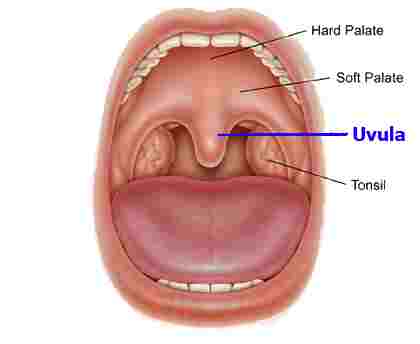 The uvula is the often depicted in cartoon scenes when the character screams and the audience sees the bell shaped uvula quivering at the back of the throat. It is believed that the uvula helps to prevent food from entering the airways during swallowing and assist producing certain sounds during speech. At the same time, it combines with the back of the throat, palate and the air coming out from the airways to produce certain other sounds as well. Due to its central position and placement, uvula can sometimes cause problems in certain individuals, particularly among those who are obese. When the interference made by the uvula becomes chronic and dangerous, doctors may adapt various surgical techniques to remove the uvula. Therefore, this article will describe the surgical interventions (uvulectomy) that are being carried out in order to correct problems associated with the uvula along with the side effects that may arise as a result.
The uvula is the often depicted in cartoon scenes when the character screams and the audience sees the bell shaped uvula quivering at the back of the throat. It is believed that the uvula helps to prevent food from entering the airways during swallowing and assist producing certain sounds during speech. At the same time, it combines with the back of the throat, palate and the air coming out from the airways to produce certain other sounds as well. Due to its central position and placement, uvula can sometimes cause problems in certain individuals, particularly among those who are obese. When the interference made by the uvula becomes chronic and dangerous, doctors may adapt various surgical techniques to remove the uvula. Therefore, this article will describe the surgical interventions (uvulectomy) that are being carried out in order to correct problems associated with the uvula along with the side effects that may arise as a result.
What are the indications to perform uvula removal surgery?
The decision to perform a uvula surgery is taken in patients with excessive snoring or in those who are suffering from obstructive sleep apnea. In both these conditions, the uvula can obstruct the airway partially or completely due to its laxity or size. In some instances, the reason for the above two conditions may not be the uvula per se but a combination of effects caused by some of the other tissues surrounding the uvula. However, before deciding on uvula removal, doctors would try all other non-invasive methods of managing snoring and obstructive sleep apnea such as losing weight, positive pressure ventilation, dental appliances and medical treatment.
Commonly uvulectomies are done for a variety of reasons including:
- Relief of snoring
- Management of sleep apnea
- Reduction of the risks of death from asphyxiation associated with angioedema (angioneurotic edema)
However uvulectomy is a relatively infrequent surgical procedure as compared to other ear, nose and throat surgeries.
Interestingly the connection between uvulectomy and Africa continues as uvulectomies are preformed in up to 20% of children at the naming ceremony within a week of birth in some African countries. Studies suggest that the reasons for uvulectomies at this young age include cultural rituals in addition to attempts to prevent growth retardation and fever. Sadly the very act of uvulectomy in these uncontrolled settings has resulted in neonatal deaths due to tetanus, bleeding and unintentional aspiration of the amputated uvula.
What are the types of uvula surgery?

While there are many surgeries aimed at relieving obstructions that may cause excessive snoring or sleep apnea, there are two main surgeries aimed at removing the uvula. These are the uvulopalatopharyngoplasty (UPPP) and Laser Assisted Uvulapalatoplasty (LAUP). However, it may be possible for doctors to combine several such surgeries at the same time in order to correct multiple causative factors.
What is the procedure involved in uvulopalatopharyngoplasty (UPPP)?
Among the two operations mentioned above, UPPP is the commonest and it has been in existence since 1981. The surgery involves an overnight stay at the hospital while it is usually performed under general anesthesia. As the name suggests, in addition to removing a portion of the uvula, the procedure also removes a rim from the soft palate along with the tonsils and any excessive pharyngeal tissues. In some instances, the same surgery would be performed in several smaller steps in which portions of tissues are removed with each and every step.
What is the procedure involved in laser assisted uvulapalatoplasty (LAUP)?
The LAUP on the other hand is a relatively new surgery introduced in the mid 1990s. It involves the use of a carbon dioxide laser to remove the uvula along with some parts of the soft palate. In contrast to the UPPP, the LAUP is performed mainly in individuals with mild obstructive sleep apnea or else in instances where snoring has become a chronic problem. It is a relatively simpler procedure than the UPPP and patients are able to return home in the same day as the surgery is usually performed at the doctor’s office.
What are the risks of the surgery?
Usually a uvulectomy (uvula excision) can be carried out under local anesthesia as a day case. The surgeon uses cautery or laser therapy to remove the uvula. In expert hands, the procedure is well tolerated. The main procedure related risks include bleeding and postoperative infection. However it is worth mentioning that the type of patient who requires a uvulectomy for sleep apnea tends to have a high body mass index and generally is at a higher risk of perioperative events.
Patients usually report some post operative pain which can be controlled by simple analgesia and avoidance of solids until healing has taken place.
Long term the main risks include impaired gag reflex with attendant risk of aspiration in addition to nasal regurgitation of food. Patients who speak languages with guttural phonetics (sometimes called uvularly speech) such as Xhosa and Turkish may notice some speech impairment.
What are the side effects of uvula surgery?
Uvula surgeries do not usually lead to life threatening complications although there is a risk of developing moderate to severe side effects in the immediately post-operative period. Among them, swelling or edema of the throat is a significant complication, which can lead to breathing difficulties needing tracheostomy insertion. In addition, these patients may also develop side effects such as sore throat, hoarseness, swallowing difficulties, excess mucus in the throat as well as problems of regurgitating stomach content. While the risk of post-operative hemorrhage is relatively less, it may also manifest as a side effect following such surgeries. However, the side effects and complications associated with LAUP are relatively less than that of UPPP and mostly dominated by side effects such as sore throat, dry throat and increased snoring.
What are the disadvantages of losing a uvula?
Interestingly the exact function of the uvula remains unclear. It is widely thought to have a role in speech and possibly in protection against infections. It had been suggested that the uvula helped animals to drink while bending down and that we humans had evolutionary remnants of this organ. However a fascinating study in Israel refuted this theory and concluded that it is indeed an accessory speech organ. Hence George Bernard Shaw was technically quite correct in 1911 when he cynically suggested that mercenary doctors could remove the uvula and leave the patient no worse off.
How much does a uvulectomy cost?
The costs of a uvulectomy varies depending on the location. There are insufficient data for policy makers to determine if it is a cost-effective intervention.

